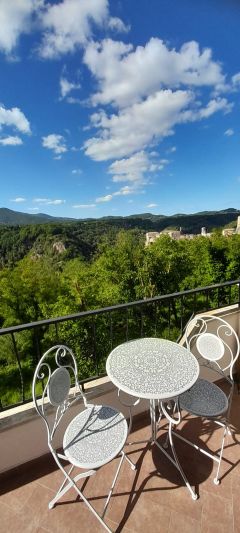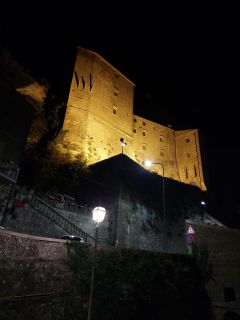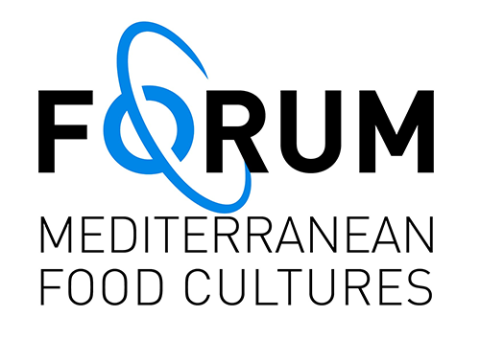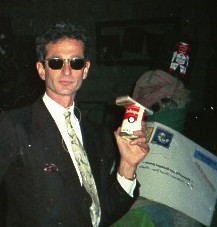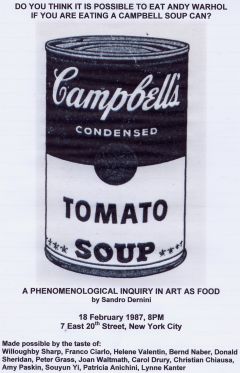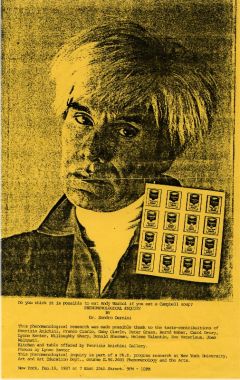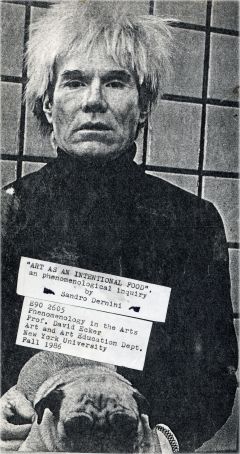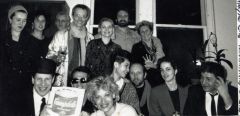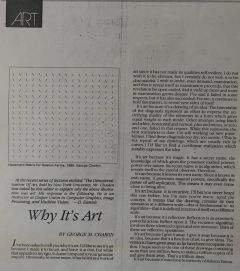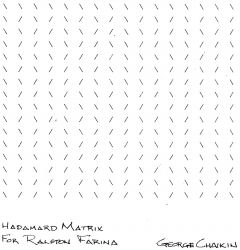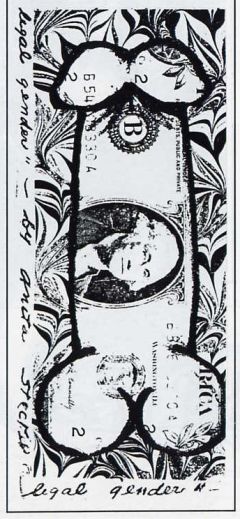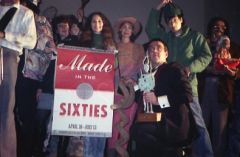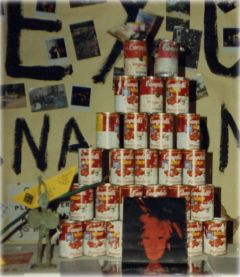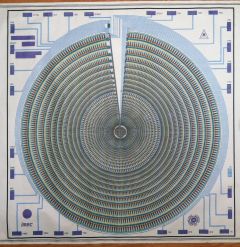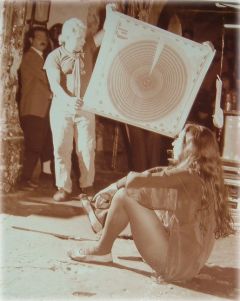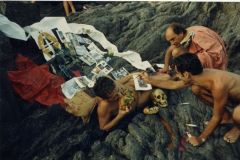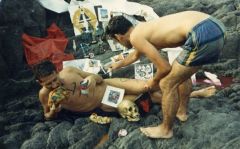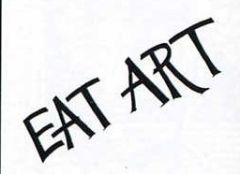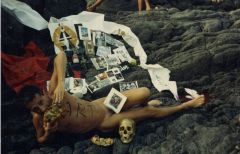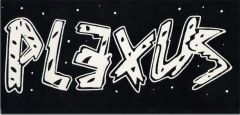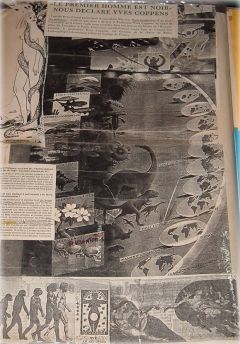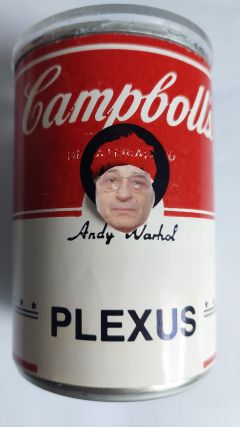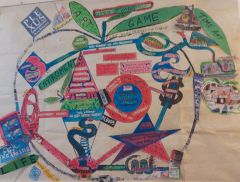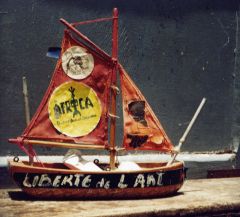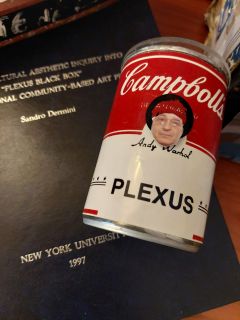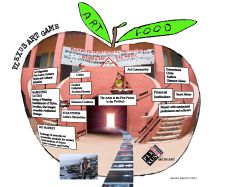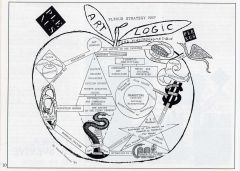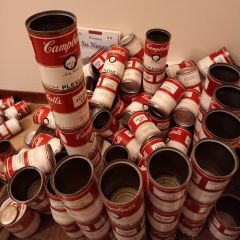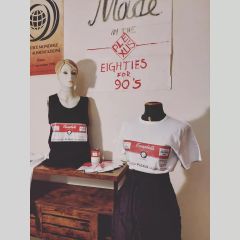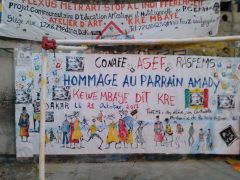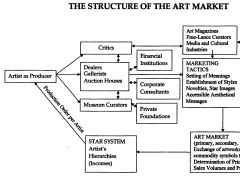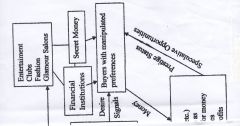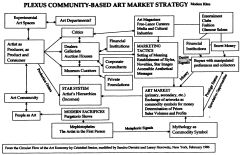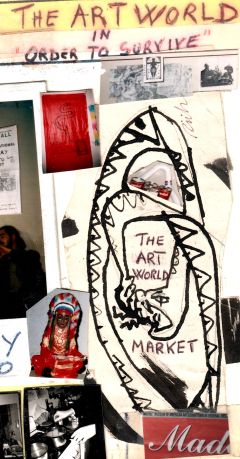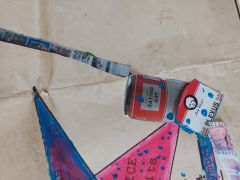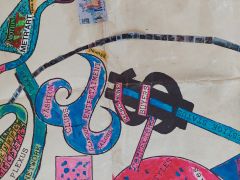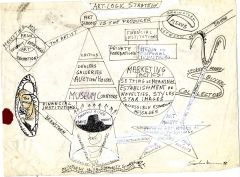![]()
DO YOU THINK THAT IT IS POSSIBLE TO EAT ANDY WARHOL BY EATING A PLEXUS CAMPBOLL'S SOUP CAN?
On 18 February 1987, in New York, at the Patrizia Anichini Gallery, I RITUALLY performed "Do you think it is possible to eat Andy Warhol if you are eating a Campbell soup? as an aesthetic inquiry for my PhD course E90.2605 on Phenomenology and the Arts at New York University, directed by prof. David W. Ecker.

Invited artists were Willoughby Sharp, Helen Valentin, Bernd Naber, Franco Ciarlo, Donald Sheridan, Peter Grass, Lynne Kanter, Souyun Yi, Carol Drury, Amy Paskin, Christian Chiansa, and the host Patrizia Anichini.
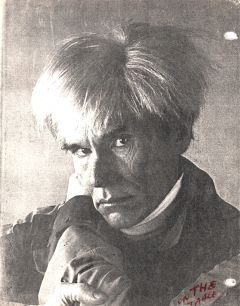
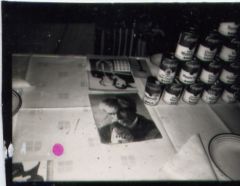

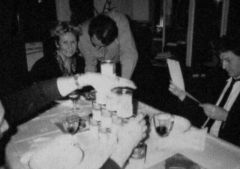
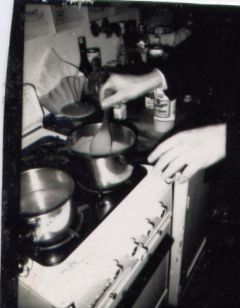
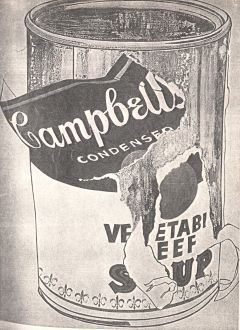
I prepared a questionnaire to be filled by participant artists after having cooked and eaten a Campbell's soup can. Seven questions I posed in the questionnaire, conceived for my phenomenological performance upon my NYU PhD course on Phenomenology and the Arts and my PhD reaserch study on "ART AS FOOD".
QUESTIONNAIRE
Do you think it is possible that you have eaten Andy Warhol when before you have eateen that Campbell soup two minutes ago?
- Suspend your belief before to answer to these questions. Answer: yes or no?
- What you mean?
- How do you know?
- How was the taste?
- Is it true or not?
- Who was the subject? Who was the object?
- Description of the experience


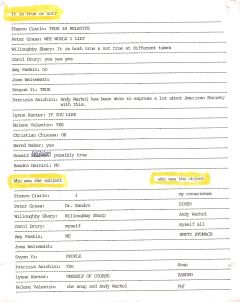
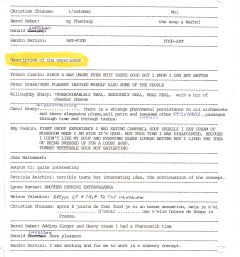


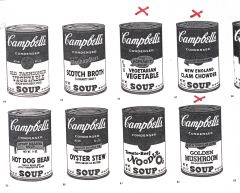
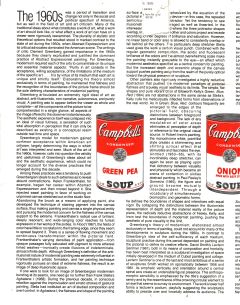
From the artist answers to the questionnaire, the majority of believed they “ate” Andy Warhol dematerialized.
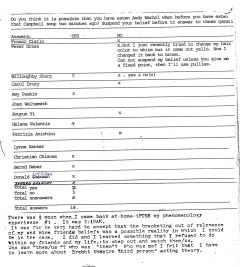
WERE WE CANNIBALS?
I prepared my phenomenological performance, by being inspired for moving forward my NYU Ph.D inquiry on "ART AS FOOD", by the symposium The Dematerialization of Art, organized the day after at New York University by Angiola Churchill and Jorge Glusberg, co-directors of ICASA (International Center for Advanced Studies in Art), where I was working as a graduate assistant of prof. Churchill, chair of the NYU Art and Art Education Dept.

Angiola Churchill
"Heisenberg's Uncertainty Principle of 1907 with its recognition that the behaviour of the atom could not be predicted proposed a new reality that the artist has only begun to grapple with. What is the status of art if a discernible reality no longer exists?
Advanced technology has vastly expanded the human sensorium. What results from this increase of information largely depends on the interpretative abilities of the artist.
Scientific breakthroughs have presented not just a new version of reality but also of time and space.
What significance this will have for art cannot yet be said but we are clearly on the brink of the most extraordinary leap in human perception".
(From the brochure of the Symposium on The Dematerialization of Art, International Center for Advanced Studies in Art, New York University, 1987)
Few nights after, on 22 February, Andy Warhol died!

At the opening of the Symposium, Lenny Horowitz and Stephen Di Lauro, two Plexus historical players, by reporting from the floor the Sandro's performance, questioned the panelist about this potential dematerialization of Andy Warhol into a Campbell's soup can.
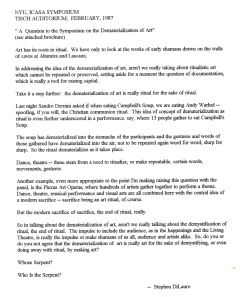
Nam June Paik, among the speakers, answered believed possible that Andy Warhol had been dematerialized through the artist intentional act of eating his commodity art symbol.
The panelists were Jean Baudrillard, Donald Kuspit, Vito Acconci, Nam June Paik, Judy Barry, Dennis Oppenheim, Billy Kluver, Nancy Holt, Paul Taylor, Bruce Breland, Flor Bex, Rene Berger, Eika Billeter, Alan Bowness, Julie Lawson, Hervè Fischer and George Chaikin.
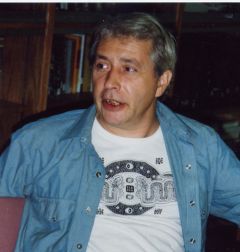
Hadamard Matrix Why it is Art
by George Chaikin, 1987
The Dematerialization of Art Symposium, ICASA International Advanced Studies in Art, New York University 1987
I’ve been asked to tell you why it’s art. I’d like to say it’s art because I made it to be art, and leave it at that, but while that appeals to my ego, it doesn’t respond to your genuine inquiry. Obviously, in some sense, it has failed as a work of art since it has not made its qualities self-evident. I do not wish it to be obvious, but I certainly do not wish it to be obscurantist. I wish to invite, even demand, examination, and that it reveals itself as examination proceeds, that this revelation be open ended, that it yield up more and more as examination grows deeper. I’ve said it failed in some respects, but it has also succeeded. For me, it continues to hold fascination, to reveal new sides of itself.
It’s art because it’s a drawing of an idea. The bimodality of the diagonals represents an effort to express the underlying duality of the elements in a form which gives equal weight to each mode. Other attempts using black and white, horizontal and vertical, plus and minus, or zero and one, failed in this respect. While this represents the best realization to date. I’m still working on new possibilities. I find these diagonals too dry, too ascetic. (This is not typical of my drawings, which are usually rich in curves.) I’d like to find a curvilinear realization which suitably expresses the idea.
It’s art because it’s magic. It has a secret name, the knowledge of which gives the possessor exalted powers, power over nature. Its secret name is its algorithm, which reveals itself to be careful observer. Therefore…
it’s art because it knows its own name.. Since it knows its own name, it possesses magical powers, specifically the power of self-replication. This means it may even come close to being alive.
It’s art because it is recursive. I’ll bet you never heard this one before, but I’m sure you’ve encountered the concept. It means that drawing contains its own reiteration at a different scale – this is fundamental to its algorithm – that it is defined in terms of itself on a different scale.
It’s art because it’s reflective. Reflection is an extremely powerful action. Reflect upon it. The recursive algorithm involves three identical copies and one inversion. Both of these are reflective operations.
It’s art because I give it away. I give it away because it is anidea, because yjay’s function of art, ti give ideas. The versions I have giving away so far been too sparse, too thin. I hope soon to do of these drawings containing more that one million lines, to make a million copies of it and give them away. That’s a trillion lines.
It’s art because it was done in memory of Ralston Farina
THE PLEXUS CIRVILINEAR GEOMETRY OF CONSCIOUNESS
In 1986, at the Plexus Art Opera n.3 "EVE- Escaping from Anno Domini" on board an art slaves ship, hundreds George's Hadamard Matrix copies were given away by Stephen DiLauro, acting as Lorenzo de' Medici, throughing them out the,m together with copies of the penis legal gender dollar by Anita Steckel while artists were sold in auctions were bought by the Royal ArtWorld Family.
Storyline Plexus Art Opera n.3 "Eve, Escaping from Anno Domini on board of an Art Slaves Ship" 1986, NYC
Let me introduce myself in the first person,
I am Plexus 23s , aka Dr. Sandro Dernini

I have a double identity, I am a Plexus artist, as well as, I am a scientist

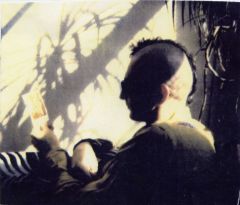

I am a compressionist artist, Plexus 23s co-founder of Plexus International
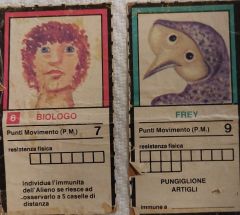
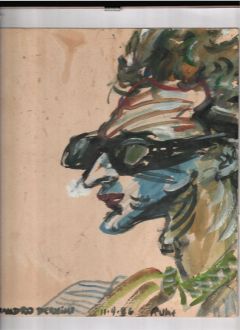

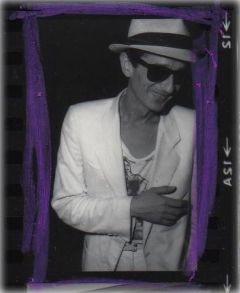
As a scientist, in 1974, I got my university degree (laurea) in Biological Science, at the University of Cagliari (Sardinia), and in 1997, I got my Ph.D. in Art Education, at the New York University.
Since early 90’s, I started to foster an enduring transdisciplinary dialogue among international scholars from different fields, connecting the well-being to the Mediterranean diet, sustainable diets and food sustainability. I published many peer reviewed scientific articles, books, and organized many international conferences and projects with United Nations and Intergovermental Organizations, including three World Conferences on the Revitalization of the Mediterranean Diets, in 2016 in Milan, in 2019 in Palermo, and in 2022 in Bari.
I have also a double cultural identity: I am “Sardo” (from Sardinian) and Italian. My nationality is Italian but my culture is "Nuragic", the bronze age civilization of Sardinia.
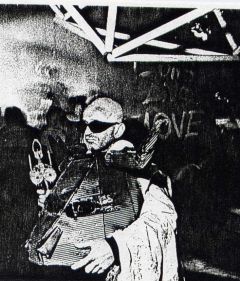
I discovered my Nuragic identity, in August 1984, in a burned building, at 523 East 6th Street, in the Lower East Side, where I was living, when prof. Raimondo De Muro, an old Sardinian friend of my family, knocked to my door, in the second floor with ruined stairs to go up to ask. He told me about the ancient oral tales of the Nuragic people of Sardinia, that did not known. He asked me to support him to find in New York a publisher for his book "I Racconti della Nuraghelogia". I was totally fascinated by his speaking on my forgotten Nuragic Sardinian heritage. Then, I introduced him to Stephen DiLauro, a playwriter living next door, and frequent at the Shuttle Theatre in my basement building. I knew that Stephen was very attracted by Robert Graves' White Goddess and by mysteries of the ancient world.
Stephen liked it and, alias E. Kishmet, he wrote "The Towers of Power", as introduction to De Muro's short book version in English, in which he
Stephen liked it and wrote an introduction to the English De Muro's book synopsis, entitled “The Towers of Power”, about synchronicity, UFOs, and “cosmic net”, questioning if thousand stone towers of varying heights exit, as the remains of a bigger ancient network could be the center of an interplanetary communication network of a universal memory.
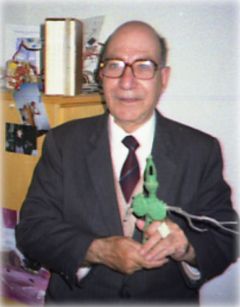


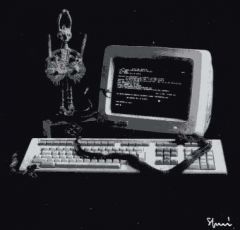
Photo Stefano Grassi
In New York, on February 20 of 1988, on the occasion of the first anniversary of my 1987 dematerialization performance of eating Andy Warhol, I RITUALLY performed the Plexus happening “An Art Redefinition of a Campbell Soup Can”, in the dried swimming pool of CUANDO Cultural Civic Center, in the Lower East Side. I organized it as a Plexus report to the Lower East Side community, about developments of the Plexus journey of the art slaves boat, two years after its departure from the “Eve” art opera, its landing in 1987 in Sardinia and its planned arrival at the House of the Slaves of Goree, Dakar, in December 1988.
I RITUALLY staged it as a recall of my 1987 Andy Warhol ’s Dematerialized inquiry. this time I was inspired by a second ICASA symposium, The Redefinition of Art in the Collision of Cultures in the Post-Modern World, held in the same period at New York University by ICASA..
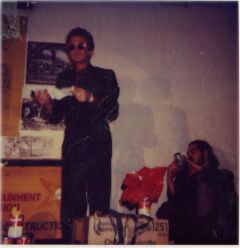
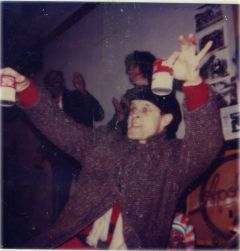
Barnaby Ruhe


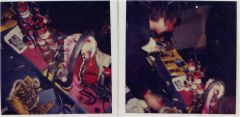
PLEXUS ART REDEFINITION OF A CAMPBELL SOUP CAN
In September 1988, for my birthday,with a party in a loft in Soho, I presented 100 Plexus Campboll's Soups Cans Labels, Made in the 80's for the 90's, as 100 Limited Editions, printed for me by Ram Studio of Maggie Reilly.

What does a PLEXUS Can look like?
It looks like an Andy Warhol's Campbell soup can, if it is exposed to a beholder of the artworld. Its label is red and white. The "e" of Campbell is changed to an "o" in Campboll's, It has a central circle with the words "Dematerialized Andy Warhol" and Andy Warhol's face which hold the center of attention. On its bottom the word PLEXUS.
It has a cylindrical form, balanced symmetrical design, a spatial organization with 2 red and white rectangular units, with written messages:
“DIRECTIONS: EATING ART and "INGREDIENTS : HISTORY OF MODERN ART, VOLUME 1- FOODART INTERNATIONAL".
Below Direction: Time Capsules Art. LTD 100 of 100. PLEXUS 23S Soup Sardinia Export. Printed in the USA
Below Ingredients: Ram Studio Inc - Designer R. Kern. New York, 5/88 AD.
The expectation as manipulation of mental imagery is a central referential step of the analysis. Changing "e" to "o" in the word Campboll’s prevents the Plexus Can being confused with a Warhol's can and with a simple Campbell’s can.
Both light and distance influence the reading of the outside codes of the object whether it is read as "e" or "o", whether you see or you do not see the glued-on penny painted as money art. The angle from which the object is viewed determines the perception of the object either as an original artwork by Plexus23s, or by Andy Warhol or a simple Campbell can.
Plexus Interpretation is not static. It is formed by the momentum of the rhythm of our experience and of its correlations. Each reader has his/her own angle of interpretation depending upon his/her personality, education, and culture. No method can transcend the interpreter's own historicity.
INGREDIENTS
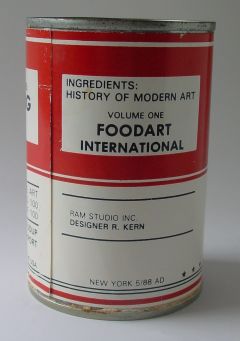
What does a Plexus Campboll’s Soup Can contain?
The content of a Plexus Campboll's Soup Can changes from Can to Can.
It depends upon the related circumstances under which a Plexus Can is made. What is inside this can is also an element of ambiguity of this art work.
What is inside this can is also an element of ambiguity of the work under study.
How will you open it?
The curiosity to open it, and the motivation to do it, will create the need of opener, as a method of reading, a system of intelligibility.
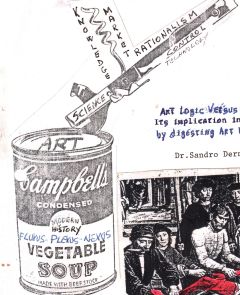
The expectation, the beholder's share, if the person is related to the art world, will transform an ordinary object, a Campbell Soup Can, into an artistic object, a PLEXUS Campboll’s Soup Can.
Plexus Can as an open work of art depends upon its community of beholders, formed by the momentum of the rhythm of that specific experience and of its correlations with my own in the first experience of this momentum.
Interpretations of clues are made by systems of intelligibility which are made by codes. Clues are supposed to be read as information. One of these clues is "Direction: -Eating Art". Another one is "Dematerialized Andy Warhol".
First question, how do we eat art, and if we eat art how do we digest it? Second question, how do we eat Andy Warhol dematerialized, and if we eat Andy Warhol how do we will digest him dematerialized?
Plexus Can functions within a ritual art performance environment depending upon the community of beholders, and their art references.
The Plexus Can, within its art altalr environment, is an intentional "bewildering image" of a work of contemporary art.
The expectation, the beholder's share is the keyplayer in the Plexus artistic process by transforming perception of PLEXUS Campboll's Soup Can into a historical contemporay artwork.
To start I applyed my 1988 NYU Course on Aethetic Inquiry, with David W. Ecker, for understanding art definitions, categories, styles, ArtWorld notion, and its exclusive priviledge of conferring the artistic identification, the status to be an "Artist".
ART DEFINITIONS, CATEGORIES, AND ART MARKET:
NAMED IT "ART-SLAVER-ISM"
Arthur Danto wrote, in his essay on “The Artworld”, to see something as art requires something the eye cannot decry-an atmosphere of artistic theory, a knowledge of the history of art: an artworld.
Andy Warhol's Brillo boxes, Danto explained, because they were made by a person with an "artistic identification" belonging to an artworld, made
them "Art".
An artifact can acquire the status of a candidate for appreciation within the system that Danto has framed and explained as "The Art World".
For instance, Duchamp's "Fountain" is not just a misplaced urinal, as Arthur Danto wrote, " Once one accepts the possibility that a Brillo box by Warhol is a work of art, while an ordinary Brillo box is not, it is plain that the differences are not of a kind that meet the eye, and that the phenomenology of perception cannot be appealed to effect the differences, which are philosophical. The point is that Warhol's box acquires, in virtue of'being art, properties ontologically unavailable to its counterpart, and the problem of the philosophy of art is to explain not just how this is possible, but what the status of these properties is, in as much as the properties would not be present to the eye if you did not know you were looking at a work of art "
Each analysis of an art work has its own historical world related to a particular time and space.
What you will see, as virtual content of that specific Plexus Campboll's Soup Can Limited Editions, is an artists time-space, a PLEXUS place, dissociated from current mundane art world environment under market control.

My Plexus Campboll’s Soup Can Limited Editions labels are only original dresses, to be perceive by the beholder, in particular circumstances of time and place. To view a whole Plexus Can out of its intended context is to see it distorted. It is an original work of art that is not possible to experience in another time and place as it was intended to be experienced.
The beholder's projection completes the missing steps, as an artistic interplay between what can be conceived, and what is perceivable and observable, as an aesthetic illusion, created by the art power suggestion on our mental set: a work of art of Plexus Campboll's Soup Can work, with inside Andy Warhol dematerialized.
Plexus Cans are metaphoric art objects, with messages to be coded and decoded in an endless Plexus deconstruction process. Its metaphoric reading is like "a serpent eating its own tail", transforming itself in the process.
Reading a PLEXUS CAMPBOLL'S Soup Can through a Plexus Compressionist Curvilinear Nuragic Deconstruction
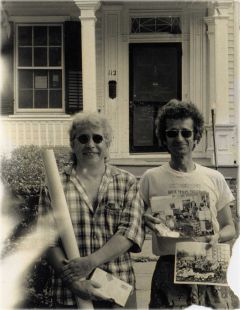


The Plexus Art Slavery Manifesto Group Photo Shots compressionist process actually contains duplicates of other group photos, which contain duplicate of other photos of Plexus historical art journey and so on more; The first frame also refers to the second frame through showing it as in a frame, etc., might then be said to quote it directly.
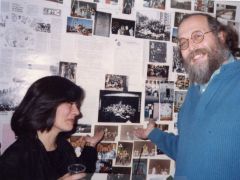



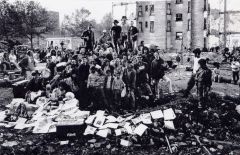
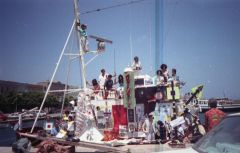
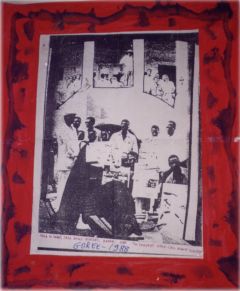
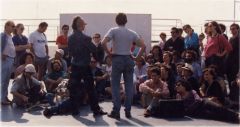
1988 PLEXUS MANIFESTO ART SLAVERY, HOUSE OF THE SLAVES, GOREE-DAKAR
As result from this deconstruction a large quantity of images and texts it was produced which may seem disconnected but instead very interconnected as frames of references of other references, direct verbal and pictorial quotations to be accounted in a proper interpretation (Then a photograph may actually contain a duplicate of a second photograph; and the first, if it also refers to the second through showing it as in a frame, etc., might then be said to quote it directly
The reading of a Plexus Can raises the problem of measuring an object /subject that is still evolving in non-linear movement and is not in equilibrium.
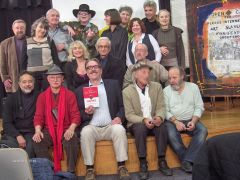
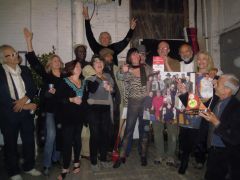

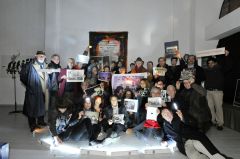
Photos by Anna Marceddu


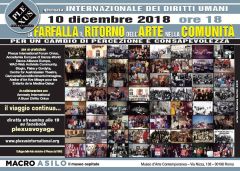
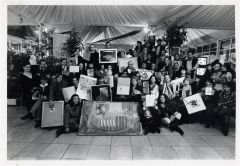
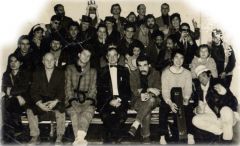
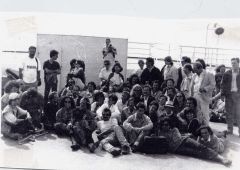
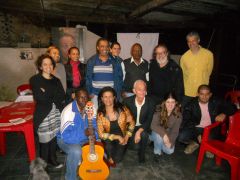

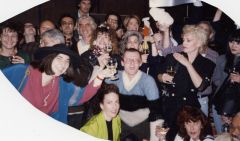

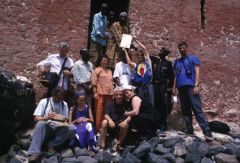
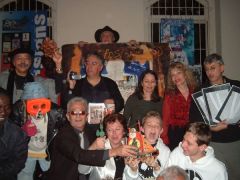
Th 1988 Plexus Art Slavery Group Shot Manifesto Roma, Metateatro became the Plexus compressionist fractal frame.
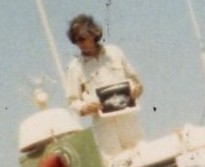
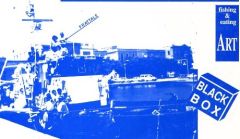
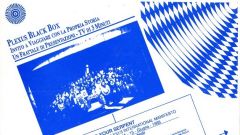
The reading of a Plexus Can raises the problem of measuring an object /subject that is still evolving in non-linear movement and is not in equilibrium, made by frames of frames of Plexus art references, like a Plexus fractal.

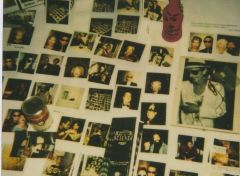
The Plexus group photo compressionist process actually contains duplicates of other group photos, which contain duplicate of other photos of Plexus historical art journey, which contains other photos,and again and again... other frames to be decoded in an endless Plexus recalling process.
With a message to be coded and decoded in an endless process of description. As a serpent eating its own tail, A Plexus Can is transforming itself in the process.
The interpretation of its pictorial representation has gradually shifted from the object to the subject. What is seen depends upon who is looking at it.
MY SELF INSIDE? MY SELF OUTSIDE?
WHO IS THE OBJECT? WHO IS THE SUBJECT?
THE ARTIST? THE ART MARKET? THE PLANET? US?


SHIFTING NOW: Who is the subject?
and who is now the object?
To start to answer to these questions, I applied lessons from my 1988 NYU Literature and the Arts course, in which the Alain's drowing came out as my main frame of reference to understand and to learn on how art was tought in the art schools to be studied and applied by future artists and art professionals.

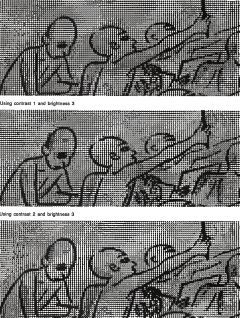


From 1988 to 2024, I created several art installations with the 100 original Campbell's Soup Cans, with forms of Pyramids, reppresenting the Art Stars System, and Nuragic Towers, repprenting the Art Community.
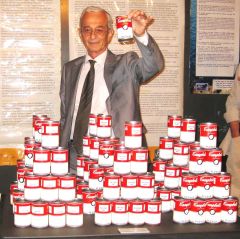
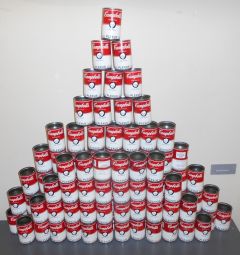

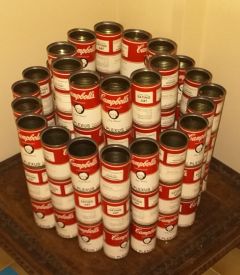
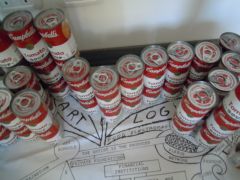


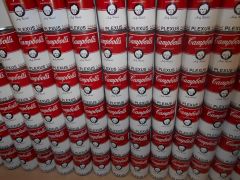
The necessity to create or to invent a new object or substance and related system of intelligibility depends on the momentum of that specific epoch. Just as there was a need to invent a food with a long shelf life.
Plexus Can was invented by me as an original work of art, an attempt at art with a long shelf life.
What you feel and see is your own creation…
We are called PLEXUS.
"Mytho-Compressionism”.
We have extended the compass of vision to include the former observer as participant. We are user friendly. Use us or lose us.
We are all independent thinkers and dreamers collating our collective visions collaboratively.
Please experience us wisely and with an open heart.
This is open ART.

(Leonard Horowitz, 1986,New York)
ART IS FOOD
A BIOLOGICAL NEED FOR OUR
EVOLUTION
In the Evolution of the Homo Sapiens corpus, Biology and Culture are interconnected by the genetic capacity to modify, convert, and transmit metabolic ionic charges as cultural messages.
The body, mind and senses are no longer the only means by which we experienced the world!!
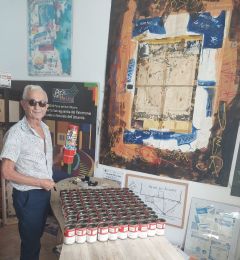
NUMBER ZERO OF THE 100 PLEXUS CAMPBOLL'S SOUP CANS LIMITED EDITIONS
After 37 years, since when in 1988 I conceived the 100 Plexus labels,
I placed myself inside of the number zero of my 100 Plexus Camboll's Soup Cans Limited Editions, only by Art Love, as a birthday homage, for Glaucia Coelho DemenjourIn the number zero for Glaucia Coelho Demenjour.
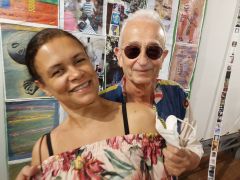
From 1988 to 2024, I tried many times to understand how to fill these 100 Plexus Cans, but it was too much for me, by being too much involved into it. Then, only for Art Love, in August 2025, I placed myself inside the number zero of the 100 Plexus Campboll's Soup Cans Limited Editions, watching myself, subject and object at the same time. as a vivisected body of art.
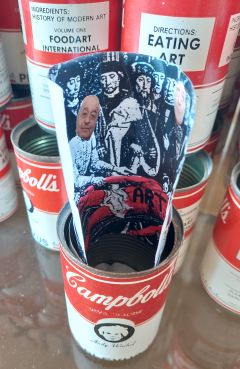
MI DENTRO/MI FUORI - MYSELF INSIDER/MYSELF OUTSIDER
I was forced by ARTLOVE to define how to fill these Plexus cans by taking into account the history from where they were coming from, in which I was part, in the first person, as an insider as well as an outsider.


DIRECTIONS-EATING ART
Plexus FoodArt High ElectromagneticIntentional ART Food
The consumption of “Art” by the human corpus can be conceived as a digestion of “Food”, by which the corpus is nourished by art, participating in the general metabolism of the human corpus.
PLEXUS FOODART INTERNATIONAL
“FoodArt” is digested into neurophysiological reactions which affect the anabolism and catabolism processes of the human corpus. Through the digestion of foodART the METABOLIC, ionic process will supplies ”ARTEnergy” for the vital activities of the human corpus. Plexus FoodART will be connected, through all its cellular parts, by the SOLAR plexus networking system of blood vessels, lymphatic fluids, and nerves.
Consequently the solar PLEXUS, interlated to a complex of PLEXUS, are connecting billions and billions of individuals cells as a whole living organism, the human being, able of reproduction, of growing, of modifications of thinking, and transmitting culture.
EATING THE HISTORY OF PLEXUS ART JOURNEY 1982-2024
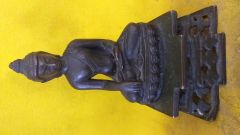
INGREDIENTS:
THE HISTORY OF MODERN ART
Volume 1
PHD NEW YORK UNIVERSITY AESTETIC INQUIRY INTO THE PLEXUS BLACK BOX BY SANDRO DERNINI
On the internal side of the Can I glued a cent coin painted in yellow as money art, glued next to the cover of the 1987 Dematerialization of Art Symposium at New York University,. Next to them I glued a collage of a middle ages vivisected body of an alive prisoner opened by the medical school, with different faces of myself watching the opening.

“ART” as an intentional invisible HIGH electromagnetic "FOOD"

Inside the can, on the bottom, a 1981 original photo of Sandro by Lynne Kanter. 1981 TIME CAPSULE NUMBER ZERO.
In 1980, I moved from Rome to New York, where I lived in a great loft in Broome Street, in Soho. I started to give funny parties to meet creative people to start to know the cultural and artist life in New York. Then, in 1981, I opened with Luigi Ballerini, at that time director of the NYU Italian Programme , the Center for Italian Contemporary Culture. As executive director, I organized the programme "THE ARTIST IN THE FIRST PERSON", with Italian independent artists, managening their own presentations.

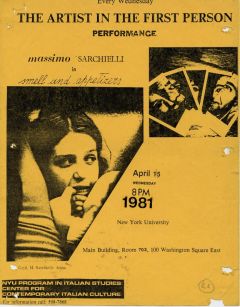
After, in 1982/83 I opened Plexus International performace space, in Chelsea.
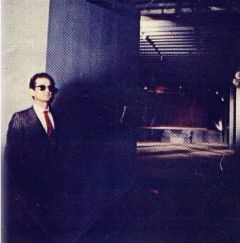

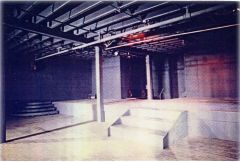
Then, 1984 I was forced to close the Plexus performance space and I opened the Shuttle Theatre/Lab in the Lower East Side.
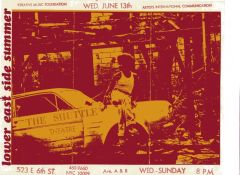
and then Plexus art journey departed and I am still on board.
I am still facing the challenge in progress of filling the number 1 of my 100 Plexus Campboll's Soup Cans Limited Editions,
as an original intentional contemporary artist attempt , with the ambition to have a long shelf life in contemporary art history.
MY NUMBER ONE PLEXUS CAN IN PROGRESS DECONSTRUCTION
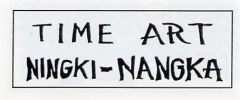


1996 PLEXUS CALL FOR AN ART WORLD BANK IN ORDER TO SURVIVE FROM ART SLAVERY


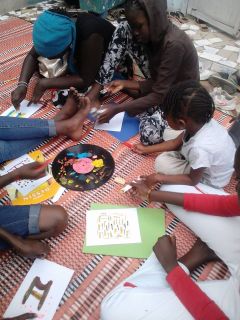


In 1987, in Gavoi, Sardinia, at the Plexus Art Co-Opera n.4, "Il Serpente di Pietra".
I burned in a ritual sacrifice with Assane MBaye my image of Plexus artistic director that was replaced by the invisible serpent Ningki-Nangka, for the continuation of my Nuragic Plexus art journey,
from Purgatorio to Paradise.
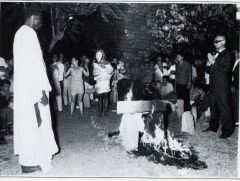
1987 Plexus Art Co-Opera n.4 "Il Serpente di Pietra", Gavoi, Sardinia
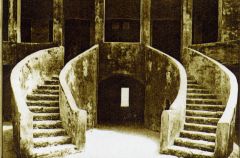
HOUSE OF THE SLAVES, GOREE-DAKAR
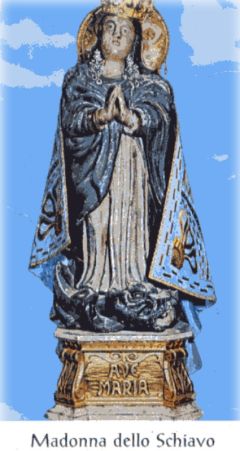
Carloforte, Island of San Pietro, Sardinia
I am learning to create my own theoretical approach on ART AS AN INTENTIONAL FOOD FOR THE EVOLUTION OF THE HUMAN BEING.
I am extending and opening my own territory, within the current limited and controlled by the art market Control, built on the Authority of the Western Culture, responsible of the schism between artists and art, and, art and people.
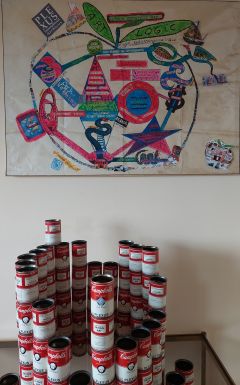
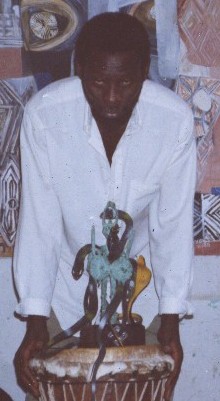
Kre MBaye
THE VOYAGE CONTINUES...
PLEXUS INTERNATIONAL OFFICIAL ARCHIVES, SORANO
The Plexus Archives in Sorano meticulously documents the events and activities of Plexus Internaional, from 1982 to 2024 and up now, with a collection of original papers by Plexus artists and historical artworks, such as the Plexus Metr'Art, a monumental contemporary artwork measuring 390.94 meters, created from 2004 to 2019, including 935 contributions from 469 artists worldwide.


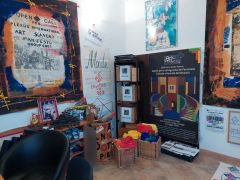

Plexus International Official Archives can be visited by appointment and overnight stay on site, at special discount fare, at the DJOUR'S Guest House of Glaucia Coelho Demenjour.
